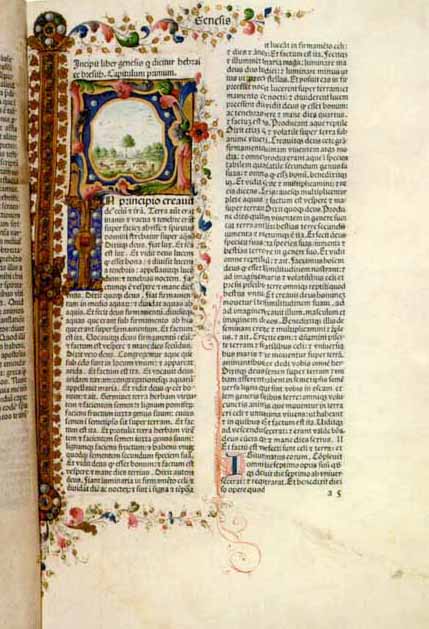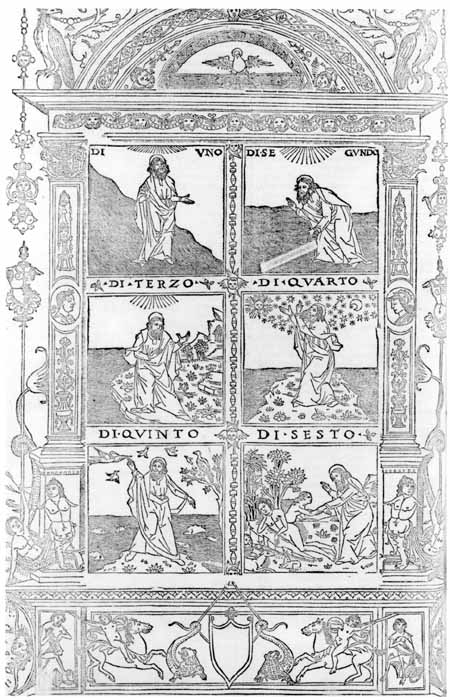The Book of the People of the Book: Guttenberg Changes History
Only two books are on permanent exhibit in the Great Hall of the Library of Congress: a perfect copy of the Gutenberg Bible printed on vellum, one of only three in the world; and the last, and arguably the finest illuminated manuscript of the Bible, the Giant Bible of Mainz. Both of these bibliophilic treasures were produced in the same city, Mainz, within two years of each other. After a separation of half a millennium, they were reunited when the great collector and benefactor of the Library, Lessing J. Rosenwald, presented to the Library the Giant Bible of Mainz manuscript on the 500th anniversary of its creation.
The Gutenberg Bible is the first major, mass-produced book produced from movable type in Europe. The earliest account of the invention of printing is in Die Cronica van der hilliger stat van Coellen (Cologne, 1499). It says:
This highly valuable art was first discovered in Germany, at Mainz on the Rhine ... in the year 1440, and from that time until the year 1450 this art and what was related to it were being investigated. In that year, 1450 ... they began to print, the first book printed, was the Bible in Latin ... And the first inventor of printing was a citizen of Mainz, born in Strasburg, and named Junker Johann Gutenberg.
In his chronicle of Jewish history, Zemah David (Prague, 1592), David Gans credits Gutenberg with the invention of printing "in the first year of the reign of virtuous Emperor Frederick," and declares:
Blessed be He, who gives man knowledge and instructs him in wisdom ... who favored us with this great invention, whose benefit to all mankind cannot be matched by any other from the day God placed man on earth.
Few if any inventions have had greater effect on the course of civilization. Printing, which replaced the long, laborious, and expensive production of manuscripts, made possible the wide dissemination of knowledge. Gutenberg's Bible is also a marvel of the beauty printing reached at its inception. This was possible because the volume is as much the last manuscript as the first printed book. That this new method of "writing" was first applied to fashioning a grand edition of Western civilization's supreme literary and religious creation, the Bible, is entirely appropriate. The same civilization which built and adorned cathedrals of grandeur could be expected to print magnificent Bibles.
Opened, the Library's Gutenberg would cover a card table. Its 1,282 pages in three volumes are bound in leather-covered wooden boards. indelible ink on supple vellum and strong Gothic letters evoke the strength of the Faith. Estimates of the Gutenberg edition range from two hundred to three hundred, those printed on vellum from twenty to thirty-five. Only twenty-one complete copies survive, six in the United States; the only one on vellum is the Library's copy. The Giant Bible is, as its name claims, a volume great in its execution as well as its dimension. Its illuminations and decorations are works of art, bold in color, delicate in detail.
The Nekcsei-Lipocz Bible, of Hungarian provenance and completed about 1342, is noted for its unusually thick vellum and for embellishments "strong and filled with fantasy." More delicate and more beautiful is another Latin Bible, written in thirteenth-century England in "most minute Gothic characters on the finest uterine vellum ... so thin as to resemble India paper, [with] many historiated initials in blue and gold, frequently spreading into the margin." Of particular beauty are tiny paintings of the baby Moses on the Nile at the beginning of the Book of Exodus, and of King David and his harp at the beginning of the Book of Psalms. This 536-page manuscript is in double columns, forty-seven lines to the page, and is less than seven inches high and five inches wide. One must marvel at the skill and eyesight of the scribe and illuminators. This lovely "pocket book" also came to the Library from Lessing Rosenwald.
 |
Printed illuminated and illustrated Bibles which came with the Rosenwald Collection are no less striking. The lovely Garden of Eden illumination, which opens the Book of Genesis of one, is appropriately serene in color and composition. To the unpracticed eye, it looks like yet another manuscript, but it is, in fact, a superb printing of the Bible on vellum by Nicolaus Jenson in Venice in 1476. The works of this master engraver and printer are esteemed and his Biblia Latina, printed on vellum, is extremely rare as well.
Another Venice edition of the Bible, in Italian translation by the monk Niccolo Malermi, Biblia Italiana (1494), contains some of the most charming early illustrations of Biblical narrative, done by an artist known only as "The Master of the Malermi Bible." Of particular interest are six woodcut panels of illustrations, which depict the six days of creation. God appears in human form, haloed and bearded, accomplishing his creation: unfolding the light on the first day; parting the waters on the second; bringing shrubs and trees forth from the earth on the third; creating a human-faced sun, crescent moon, and satellite stars on the fourth and the birds of heaven and fish in the sea on the fifth. On the sixth and final day of labors, God is shown drawing Eve from Adam's side, a benign lion and a seemingly amused or startled rabbit looking on.
 |
Sources: Abraham J. Karp, From the Ends of the Earth: Judaic Treasures of the Library of Congress, (DC: Library of Congress, 1991).


